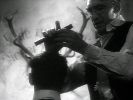Eye For Film >> Movies >> Institute Benjamenta, Or This Dream People Call Human Life (1995) Film Review
It opens with a riddle that has no solution – or, more accurately, whose solution is 'nothing'. It features an alternative title (This Dream People Call Human Life) that baldly advertises its status as allegory. It ends with a visual paradox that breaks down the distinction between viewer and viewed, inside and outside. Its official stills photographer Jill Furmansky has described it as "a largely incomprehensible, sometimes disturbing, but always ravishing film", while its lead actress Alice Krige admits that her first response upon reading the script was: "I don't understand it at all."
All of which is to say that Institute Benjamenta is the proverbial riddle wrapped in a mystery inside an enigma. Freely adapted from the 1909 novella 'Jakob von Gunten' and other writings by Swiss modernist (and asylum frequenter) Robert Walser, this is a film of layered moods and textures rather than broad narrative sweeps, and yet the hermeneutic labyrinth whose shadowy corridors it traces is (to paraphrase Virgil's words on the Underworld) easy enough to enter, but rather more difficult to leave. After all, its obsessive themes and images will continue haunting the hallways of your mind long after its well-honed sound design has finally fallen silent.

"In order", as he says, "to acquire the necessary knowledge for being a servant," Jakob von Gunten (Mark Rylance) enrols himself at the Institute Benjamenta, an ageing establishment which shares its premises with a perfumery on the outskirts of an unnamed town. No sooner has he arrived than the authoritarian principal Johannes Benjamenta (Gottfried John) takes his measure ("you're all one size here") – and shortly after Jakob joins six fellow students in the class run by Johannes' grave sister Lisa (Krige) and her dutiful assistant Kraus (Daniel Smith).
In spite, or perhaps because, of Jakob's oxymoronic claim that his "modesty knows no bounds", he at first hardly seems suited to a life of unquestioning service and submission. He is openly contemptuous of all the ritualised lessons, refuses to eat the food served in the refectory, and begs to be given "a decent room to sleep in", taking up lodgings in a garret above and apart from his comrades' shared dormitory. Yet as Jakob explores, whether in dreams or wakefulness, the mysterious interiors of the building, and is initiated in the 'monotonous repetitions' of Lisa's instructions, he starts to become lost to self-negation – and this 'beatification of zero' makes him the confused repository of both Benjamenta siblings' long repressed fantasies and desires.
Like Walerian Borowczyk with Goto, L'Île d'Amour (1968) and David Lynch with Eraserhead (1977), the twins Timothy and Stephen Quay smoothed their transition from animated shorts to full-blown live-action feature by presenting a mannered, monochrome vision of a hermetic, theatricalised world. The strange postures and events staged here follow the logic of dreams, fixating fetishistically upon objects as much as characters, and reducing the viewer to a near hypnotic state. Here suggestion is all and – thanks in part to DP Nic Knowland's use of ever-shifting light – clarity is only ever fleeting.
"Perhaps", speculates Jakob, "there is some hidden meaning to all these nothings." After all, nothing itself is a recurring motif, enshrined in both the 0s that appear in different guises throughout the film and even in the circular nature of the narrative itself, beginning and ending with a line that denies beginning or ending: "All around hangs a slumber upon these halls, and things as yet unfathomed still occur."
Or perhaps, as Jakob imagines later, he is "living in a fairytale", for Lisa, a somnolent beauty with seven clownish attendants, expressly compares herself to Snow White, while the Institute itself at times resembles a pine forest from darkest folklore and is crammed with depictions or indeed actual body parts of mythic deer (including a display case containing the 'powdered ejaculate' taken from a stag in rut).
Perhaps the titular establishment is a curiosity shop, or a nightmare, or a tomb, or a fish bowl, or a snow globe. What is certain, however, is that Institute Benjamenta is a place redolent with the heady scent of eros and thanatos, and full of the mysteries of life. Exquisitely lit and framed, expressionistically performed, and featuring the most hallucinatory focus pulls ever realised in cinema, it is an abstract, uncanny experience which, like any good servant, is far too tactful just to blurt out its masters' secrets.
Reviewed on: 17 May 2010If you like this, try:
Goto, L'Île D'AmourInnocence
The Piano Tuner Of Earthquakes
The Quay Brothers: The Short Films, 1979-2003




















